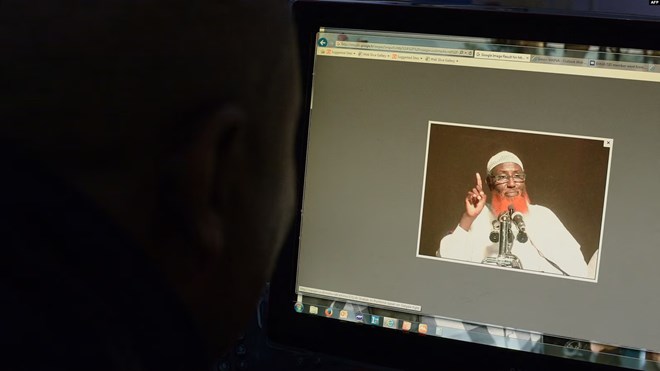
Tuesday June 18, 2024
FILE - A man looks at a computer screen displaying an image of Somali-born cleric and Islamic State-Somalia leader Abdulqadir Mumin, in Nairobi, Kenya, Sept. 1, 2016. Mumin was targeted in an airstrike late last month, according to U.S. officials.
WASHINGTON — The United States is sharpening its counterterrorism focus on Somalia, going after increasingly high-profile targets linked to a resurgence of the Islamic State terror group from its base in the Horn of Africa.
U.S. officials are concerned that IS-Somalia, as the terror group’s regional affiliate is known, has moved from being a key cog in the Islamic State global financial network to hosting the group’s top leader.
Top IS leaders “view Africa as a place where they should invest, where they are more permissive and able to operate better and more freely, and they want to expand,” according to a senior U.S. defense official. “So, they did bring the caliph to that region.”
The U.S. assessment follows a flood of rumors emanating from Somalia that the IS emir, Abu Hafs al-Hashemi al-Qurashi, traveled from Syria or Iraq and then through Yemen to the semi-autonomous Puntland region of Somalia in country’s northeast.
It also follows warnings from multiple Somali security officials that IS-Somalia has grown stronger, due in part to an influx of fighters and operatives from Yemen.
As evidence of the magnified U.S. focus on IS in Somalia, a second U.S. official confirmed to VOA on Monday that an airstrike late last month in the vicinity of Dhaadaar, 81 kilometers southeast of the city of Bosaso, targeted IS-Somalia leader Abdulqadir Mumin.
U.S. Africa Command’s initial assessments of the May 31 strike indicated three IS militants were killed. The U.S. official told VOA on Monday, however, that it is not clear if Mumin is one of the dead.
Multiple Somali security officials told VOA that their initial analysis has yet to turn up evidence that Mumin was killed, though as many as three Somalis and three foreigners were wounded.
One Somali security official said he doubted Mumin would have been in the area during the strike since the IS-Somalia leader is careful to avoid areas where telecommunication infrastructure is working, which it was at the time.
Regardless of the outcome of the strike, U.S. officials say their focus will not waver.
“We would absolutely say, unequivocally, that we’ve got to keep our eye on the terrorist threat,” White House national security communications adviser John Kirby told reporters Monday, referencing the strike in Somalia.
“It’s clear that the threat is still real, and we have to still go after it,” he said.
But word that IS, also known as ISIS or Daesh, has sent its global leader to Somalia, along with reports that Mumin himself may have been elevated to the position of caliph, is being met with skepticism from some former counterterrorism officials and analysts.
“The importance of Mumin, ISIS-Somalia, ISCAP [Islamic State Central Africa Province] and the al-Karrar office is not in doubt,” said Edmund Fitton-Brown, a former senior United Nations counterterrorism official who currently serves as a senior adviser for the nonprofit Counter Extremism Project.
“But ISIS is a profoundly racist organization, and they like to claim that the caliph is descended from Muhammad,” he told VOA. “I don’t believe they are ready for an African caliph.”
There are also questions as to why IS would send its top leader on a long and potentially perilous journey from Syria or Iraq to Somalia.
“It would be difficult from a logistic perspective. But, certainly, they could through human smuggling or networks that exist already,” said Colin Clarke, director of research at the global intelligence firm, The Soufan Group.
“My question would be to what end? What kind of infrastructure is there on the ground that this person could slot into and still be relevant,” Clarke told VOA. “It's not like Somalia is a place where you're free from counterterrorism actions … It's not outside of the targeting scope of the U.S. intelligence community.”
Clarke, like other analysts who spoke to VOA, also cautioned against underestimating IS-Somalia.
Despite IS-Somalia’s small size — estimated at 100 to 400 fighters — and its failure to control significant territory, Clarke said the IS affiliate has become a “linchpin to the group's broader global logistics network.”
That assessment is supported by a series of reports from the United Nation’s own counterterrorism experts, based on intelligence from U.N. member states.
As far back as 2022, they identified Somalia as home to al-Karrar, one of nine regional offices established to help sustain the terror group’s global capabilities.
The office, overseen most recently by IS-Somalia’s Mumin, has since evolved into a key financial hub, moving money from Yemen to Afghanistan to help buy weapons and pay the salaries of IS fighters in Somalia, Mozambique and the Democratic Republic of Congo.
More recent assessments also contend that IS-Somalia, through the al-Karrar office, has been funding the IS Afghan affiliate, sending $25,000 a month in cryptocurrency to the group, known as IS-Khorasan Province.
Such continued growth for the al-Karrar office could point to a bigger, pivotal role for its leader, Mumin.
“With IS-Somalia and the al-Karrar office being this key middle point between various provinces, [Mumin] could be the head of the general director of provinces, meaning the main person that’s helping to implement the [IS] strategy globally,” said Aaron Zelin, a fellow at the Washington Institute for Near East Policy who specializes in jihadism.
“In the past somebody in that level was previously either in Iraq or Syria,” Zelin told VOA, adding that while IS as an organization has long looked to Africa for growth, its core identity is tied to the Middle East.
“I still think that the heart of the organization, even if it's not as strong as it has been in the past, is based in Iraq and Syria,” he said.